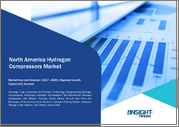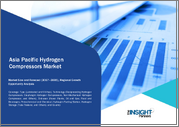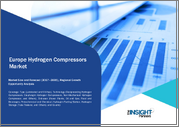
|
시장보고서
상품코드
1666026
세계의 수소 압축기 시장 규모, 점유율, 성장 분석 : 유형별, 윤활 유형별, 설계별, 용도별, 지역별 - 산업 예측(2025-2032년)Hydrogen Compressor Market Size, Share, and Growth Analysis, By Type (Mechanical Compressor, Non-mechanical Compressor), By Lubrication Type (Oil-based, Oil-free), By Design, By Application, By Region - Industry Forecast 2025-2032 |
||||||
수소 압축기 세계 시장 규모는 2023년 21억 달러, 2024년 22억 달러에서 2032년에는 31억 7,000만 달러로 성장할 것으로 예상되며, 예측 기간(2025-2032년) 동안 4.7%의 연평균 복합 성장률(CAGR)을 보일 전망입니다.
지속 가능한 에너지로의 전환이 가속화됨에 따라 수소는 미래 에너지 전망에서 중요한 요소로 부상하고 있습니다. 각국 정부는 수소 이용을 촉진하기 위해 생산 보조금, 인프라 투자, 연구 보조금 등의 인센티브를 제공하고 있으며, 이는 수소 컴프레서 시장의 성장을 크게 촉진하고 있습니다. 정제 및 암모니아 제조와 같은 산업 부문도 청정 공정을 위해 수소 소비를 늘리고 있으며, 이는 압축기 수요를 더욱 증가시키고 있습니다. 수소 충전소의 확대는 수소 자동차의 보급에 필수적이며, 고압 가스를 처리할 수 있는 첨단 컴프레서가 필요합니다. 오일 프리 컴프레서 및 최신 냉각 시스템과 같은 기술 발전은 수소 컴프레서 분야 시장 확장을 촉진하여 가격과 성능을 향상시키고, 유지보수 및 에너지 효율 문제를 해결하기 위해 수소 컴프레서 분야 시장 확장을 촉진할 것입니다.
목차
서론
- 조사 목적
- 조사 범위
- 정의
조사 방법
- 정보 조달
- 2차와 1차 데이터 방법
- 시장 규모 예측
- 시장 전제조건과 제한
주요 요약
- 세계 시장 전망
- 공급과 수요 동향 분석
- 부문별 기회 분석
시장 역학과 전망
- 시장 개요
- 시장 규모
- 시장 역학
- 성장 촉진요인과 기회
- 성장 억제요인과 과제
- Porter의 Five Forces 분석
주요 시장 인사이트
- 중요 성공 요인
- 경쟁 정도
- 주요 투자 기회
- 시장 생태계
- 시장의 매력 지수(2024년)
- PESTEL 분석
- 거시경제 지표
- 밸류체인 분석
- 가격 분석
- 규제 상황
- 사례 연구
- 기술 진보
수소 압축기 시장 규모 : 유형별&CAGR(2025-2032년)
- 시장 개요
- 기계식 압축기
- 비기계식 압축기
수소 압축기 시장 규모 : 윤활 유형별&CAGR(2025-2032년)
- 시장 개요
- 오일
- 오일 프리
수소 압축기 시장 규모 : 설계별&CAGR(2025-2032년)
- 시장 개요
- Single-stage
- Multi-stage
수소 압축기 시장 규모 : 용도별&CAGR(2025-2032년)
- 시장 개요
- 발전소
- 수소 충전소
- 산업용 용광료
- 석유화학 및 화학
- 의약품
- 석유 및 가스
- 기타
수소 압축기 시장 규모 : 지역별&CAGR(2025-2032년)
- 북미
- 미국
- 캐나다
- 유럽
- 독일
- 스페인
- 프랑스
- 영국
- 이탈리아
- 기타 유럽
- 아시아태평양
- 중국
- 인도
- 일본
- 한국
- 기타 아시아태평양
- 라틴아메리카
- 브라질
- 기타 라틴아메리카
- 중동 및 아프리카
- GCC 국가
- 남아프리카공화국
- 기타 중동 및 아프리카
경쟁 정보
- 주요 5개사 비교
- 주요 기업의 시장 포지셔닝(2024년)
- 주요 시장 기업이 채택한 전략
- 최근 시장 동향
- 기업의 시장 점유율 분석(2024년)
- 주요 기업 개요
- 기업 상세
- 제품 포트폴리오 분석
- 기업 부문별 점유율 분석
- 매출 전년대비 비교(2022-2024)
주요 기업 개요
- Atlas Copco AB(Sweden)
- Key Developments
- Siemens Energy(Germany)
- Air Products and Chemicals, Inc.(United States)
- Ingersoll Rand(United States)
- Mitsubishi Heavy Industries Ltd.(Japan)
- Hitachi Industrial Products Ltd.(Japan)
- HAUG Sauer Kompressoren AG(Switzerland)
- Kobe Steel Ltd.(Japan)
- Howden Group(United Kingdom)
- Neuman & Esser Group(Germany)
- Sundyne Corporation(United States)
- Adicomp S.r.l.(Italy)
- Ariel Corporation(United States)
- Fluitron, Inc.(United States)
- PDC Machines, Inc.(United States)
- Burckhardt Compression AG(Switzerland)
- Gardner Denver Nash(United States)
- J.P. Sauer & Sohn Maschinenbau GmbH(Germany)
결론과 제안
LSH 25.04.03Global Hydrogen Compressor Market size was valued at USD 2.1 billion in 2023 and is poised to grow from USD 2.2 billion in 2024 to USD 3.17 billion by 2032, growing at a CAGR of 4.7% during the forecast period (2025-2032).
As the global shift towards sustainable energy accelerates, hydrogen is emerging as a critical component in the future energy landscape. Governments worldwide are implementing incentives such as production subsidies, infrastructure investments, and research grants to promote hydrogen usage, significantly driving growth in the hydrogen compressor market. Industrial sectors, including refining and ammonia production, are also increasing their hydrogen consumption for cleaner processes, further boosting compressor demand. The expansion of hydrogen refueling stations is vital for the adoption of hydrogen vehicles, necessitating advanced compressors capable of high-pressure gas handling. Technological advancements, such as oil-free compressors and modern cooling systems, enhance affordability and performance, addressing maintenance and energy efficiency challenges, thus fostering market expansion in the hydrogen compressor sector.
Top-down and bottom-up approaches were used to estimate and validate the size of the Global Hydrogen Compressor market and to estimate the size of various other dependent submarkets. The research methodology used to estimate the market size includes the following details: The key players in the market were identified through secondary research, and their market shares in the respective regions were determined through primary and secondary research. This entire procedure includes the study of the annual and financial reports of the top market players and extensive interviews for key insights from industry leaders such as CEOs, VPs, directors, and marketing executives. All percentage shares split, and breakdowns were determined using secondary sources and verified through Primary sources. All possible parameters that affect the markets covered in this research study have been accounted for, viewed in extensive detail, verified through primary research, and analyzed to get the final quantitative and qualitative data.
Global Hydrogen Compressor Market Segments Analysis
Global Hydrogen Compressor Market is segmented by Type, Lubrication Type, Design, Application and region. Based on Type, the market is segmented into Mechanical Compressor and Non-mechanical Compressor. Based on Lubrication Type, the market is segmented into Oil-based and Oil-free. Based on Design, the market is segmented into Single-stage and Multi-stage. Based on Application, the market is segmented into Power Plants, Hydrogen Refueling Station, Industrial Furnaces, Petrochemical & Chemical, Pharmaceuticals, Oil & Gas and Others. Based on region, the market is segmented into North America, Europe, Asia Pacific, Latin America and Middle East & Africa.
Driver of the Global Hydrogen Compressor Market
The global Hydrogen Compressor market is significantly influenced by several key factors, including the surge in population, industrial advancements, and the increased reliance on electricity, all of which contribute to rising greenhouse gas emissions. In line with the commitments made during the United Nations Climate Change Conference in Copenhagen, countries are striving to reduce carbon emissions by 45% by 2030 to achieve a global temperature rise limit of either 2 degrees Celsius or 1.5 degrees Celsius and aim for net-zero emissions by 2050. Various governmental initiatives aimed at curbing greenhouse gases and promoting clean energy solutions, particularly hydrogen, are expected to significantly drive the demand for hydrogen compressors worldwide.
Restraints in the Global Hydrogen Compressor Market
The global hydrogen compressor market faces significant constraints primarily due to high startup costs associated with procuring and installing the necessary equipment and infrastructure. The initial investment in hydrogen compression equipment alone contributes to 30%-40% of the overall compression costs. Additionally, the compressors designed for hydrogen gas must meet stringent safety and technical standards, often necessitating the use of more costly materials and advanced engineering designs for production. These factors collectively hinder market growth by elevating the financial barrier to entry for businesses looking to adopt or expand hydrogen compression capabilities.
Market Trends of the Global Hydrogen Compressor Market
The Global Hydrogen Compressor market is experiencing significant momentum, driven by the surging demand for fuel cell electric vehicles (FCEVs). As consumers and manufacturers pivot towards more sustainable transportation solutions, FCEVs are gaining traction due to their extended range and zero-emission operation, with water vapor as the sole byproduct. This shift is prompting substantial investments in research and development of hydrogen fueling technology and infrastructure, amplifying the need for efficient hydrogen compression systems. As environmental regulations tighten and public interest in clean energy grows, the hydrogen compressor market is set to expand, highlighting its critical role in supporting the transition to a greener automotive landscape.
Table of Contents
Introduction
- Objectives of the Study
- Scope of the Report
- Definitions
Research Methodology
- Information Procurement
- Secondary & Primary Data Methods
- Market Size Estimation
- Market Assumptions & Limitations
Executive Summary
- Global Market Outlook
- Supply & Demand Trend Analysis
- Segmental Opportunity Analysis
Market Dynamics & Outlook
- Market Overview
- Market Size
- Market Dynamics
- Drivers & Opportunities
- Restraints & Challenges
- Porters Analysis
- Competitive rivalry
- Threat of substitute
- Bargaining power of buyers
- Threat of new entrants
- Bargaining power of suppliers
Key Market Insights
- Key Success Factors
- Degree of Competition
- Top Investment Pockets
- Market Ecosystem
- Market Attractiveness Index, 2024
- PESTEL Analysis
- Macro-Economic Indicators
- Value Chain Analysis
- Pricing Analysis
- Regulatory Landscape
- Case Studies
- Technological Advancement
Global Hydrogen Compressor Market Size by Type & CAGR (2025-2032)
- Market Overview
- Mechanical Compressor
- Non-mechanical Compressor
Global Hydrogen Compressor Market Size by Lubrication Type & CAGR (2025-2032)
- Market Overview
- Oil-based
- Oil-free
Global Hydrogen Compressor Market Size by Design & CAGR (2025-2032)
- Market Overview
- Single-stage
- Multi-stage
Global Hydrogen Compressor Market Size by Application & CAGR (2025-2032)
- Market Overview
- Power Plants
- Hydrogen Refueling Station
- Industrial Furnaces
- Petrochemical & Chemical
- Pharmaceuticals
- Oil & Gas
- Others
Global Hydrogen Compressor Market Size & CAGR (2025-2032)
- North America (Type, Lubrication Type, Design, Application)
- US
- Canada
- Europe (Type, Lubrication Type, Design, Application)
- Germany
- Spain
- France
- UK
- Italy
- Rest of Europe
- Asia Pacific (Type, Lubrication Type, Design, Application)
- China
- India
- Japan
- South Korea
- Rest of Asia-Pacific
- Latin America (Type, Lubrication Type, Design, Application)
- Brazil
- Rest of Latin America
- Middle East & Africa (Type, Lubrication Type, Design, Application)
- GCC Countries
- South Africa
- Rest of Middle East & Africa
Competitive Intelligence
- Top 5 Player Comparison
- Market Positioning of Key Players, 2024
- Strategies Adopted by Key Market Players
- Recent Developments in the Market
- Company Market Share Analysis, 2024
- Company Profiles of All Key Players
- Company Details
- Product Portfolio Analysis
- Company's Segmental Share Analysis
- Revenue Y-O-Y Comparison (2022-2024)
Key Company Profiles
- Atlas Copco AB (Sweden)
- Company Overview
- Business Segment Overview
- Financial Updates
- Key Developments
- Siemens Energy (Germany)
- Company Overview
- Business Segment Overview
- Financial Updates
- Key Developments
- Air Products and Chemicals, Inc. (United States)
- Company Overview
- Business Segment Overview
- Financial Updates
- Key Developments
- Ingersoll Rand (United States)
- Company Overview
- Business Segment Overview
- Financial Updates
- Key Developments
- Mitsubishi Heavy Industries Ltd. (Japan)
- Company Overview
- Business Segment Overview
- Financial Updates
- Key Developments
- Hitachi Industrial Products Ltd. (Japan)
- Company Overview
- Business Segment Overview
- Financial Updates
- Key Developments
- HAUG Sauer Kompressoren AG (Switzerland)
- Company Overview
- Business Segment Overview
- Financial Updates
- Key Developments
- Kobe Steel Ltd. (Japan)
- Company Overview
- Business Segment Overview
- Financial Updates
- Key Developments
- Howden Group (United Kingdom)
- Company Overview
- Business Segment Overview
- Financial Updates
- Key Developments
- Neuman & Esser Group (Germany)
- Company Overview
- Business Segment Overview
- Financial Updates
- Key Developments
- Sundyne Corporation (United States)
- Company Overview
- Business Segment Overview
- Financial Updates
- Key Developments
- Adicomp S.r.l. (Italy)
- Company Overview
- Business Segment Overview
- Financial Updates
- Key Developments
- Ariel Corporation (United States)
- Company Overview
- Business Segment Overview
- Financial Updates
- Key Developments
- Fluitron, Inc. (United States)
- Company Overview
- Business Segment Overview
- Financial Updates
- Key Developments
- PDC Machines, Inc. (United States)
- Company Overview
- Business Segment Overview
- Financial Updates
- Key Developments
- Burckhardt Compression AG (Switzerland)
- Company Overview
- Business Segment Overview
- Financial Updates
- Key Developments
- Gardner Denver Nash (United States)
- Company Overview
- Business Segment Overview
- Financial Updates
- Key Developments
- J.P. Sauer & Sohn Maschinenbau GmbH (Germany)
- Company Overview
- Business Segment Overview
- Financial Updates
- Key Developments



















